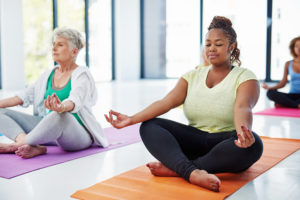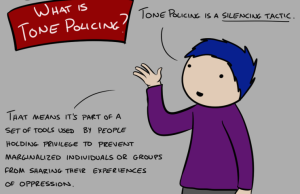
A group of people sit on yoga mats in the Sukhasana pose.
Originally published on Decolonizing Yoga and republished here with their permission.
Yoga teachers are basically aware that it’s good to encourage students. We’re expected to use encouraging language.
And yet, encouragement is a culturally bound notion. And in a culture rife with fat hatred and size/age/ability hierarchy, encouragement can mean different things to different people.
(Have you ever been in a class with a teacher who finds it encouraging to tell you how you’re going to get a tighter butt doing a certain movement, for instance? As if that’s even true or possible for all.)
The language we use with others often mirrors the language we use with ourselves, inside.
And, wow, most of us aren’t consistent in wishing ourselves well. Those negative sentiments can sneak out in word choice and sentence construction in ways other people can feel.
We are all working with socialization that says that some bodies are “better” than others. Some bodies are not very lovable; they’re invisible, untouchable, pitiable.
We all carry those scripts – whether we choose to read from them, edit them, or hide them. We carry our cultural scripts.
That’s the thing about socialization: With awareness, we can decide what to do with those scripts. The influences of culture will always be there, and we can learn to speak and behave differently through practice.
One of the reasons I began to love yoga was that it allowed me to focus on the strength and flexibility in my large body in ways that other athletic pursuits rarely allowed. I didn’t need speed or competitiveness and, when practicing properly, other yogis look within – not at each other.
As a large, active woman, I’ve been looked at plenty. Yoga was a respite, with one exception: props.
I practiced in an Iyengar-style studio, and there was a lot of up and down to do the following: get three blankets, put away two, grab a block, pull the horse away from the wall, get a chair, and put away the straps.
Sometimes, if a student tarried getting the blanket folded properly or the strap positioned appropriately, other students stared.
For me, two props took my anonymity – the metal folding chair and the strap. I won’t try to explain what we were doing with these items, but here’s the short of it: Sometimes my body was too wide for the chair and too big for the strap.
At least, that’s how I thought of it when I couldn’t follow the instructions as the other students had. I failed at using simple everyday tools because, once again, I was too fat.
But that’s not how my teacher, Sherri, saw it. The props in yoga are tools to help the body move more deeply, and with greater alignment, into a pose. There’s no merit or miracle inherent in their use. They’re just things that help when they help – or they can be tossed aside if they’re not helpful.
The first time I said “I’m too big to fit through the chair back,” Sherri just smiled and restated my situation.
“Oh, this chair isn’t the right prop for your backbend. Let’s find another prop that will work.”
Focused on my task, I hardly noticed her reframe. I was just glad to leave the chair behind and work with some blocks instead.
My teacher thought it was important that I get it, though – so she spoke more directly to me after one such reframe in class. Apparently, I had used the “there’s something wrong with my body” frame on numerous occasions.
In private, after class, she said, “You know, when a pose or the props aren’t working for you, there’s nothing wrong with you.”
I said “I know” in that too-quick manner of those who think they know, but really don’t understand deeply. I mean, I did know, in an intellectual, superficial way.
“No,” she told me gently, “what I mean is that when you say you’re too big for the chair, what’s really true is that the chair is too small for you. And it’s my job to find you an alternative.”
She stared for a moment, as this subtle difference sunk in. Then she added, “I’ve ordered some longer straps, and there’s a bench modification that will work instead of the chair.”
She was so matter-of-fact, as though none of this was personal at all. It stunned me how touched I felt.
Not only was my body not the problem – my body was worth re-engineering the external circumstances. I had never seen it that way before.
Someone with a disability deserves modifications, thought I. Fat was always framed differently, somehow a choice. How could this be, that the extra expense of new props was warranted?
Lest I was planning to take any of this personally, she clarified, “I didn’t get new props for you. I got them for differently shaped and sized bodies, that’s all. You’re a regular participant in my studio – and there are a few other students who could benefit from these props. If the body shape exists in my studio, I’ll find props to help create the benefits of the postures – simple as that. Your body just is, Kimberly. You have a beautiful yoga practice. And so we’ll rise to the occasion.”
I was speechless.
She hugged me warmly and ushered me out the door, as she deemed our talk complete. I sat in my car and cried for a few moments, taking in my body’s feeling of is-ness.
I actually felt my right to be exactly as I am. I felt it in my recently opened hips, in my extended triceps, and in my heart-center. That had been one heck of a yoga class.
I try to teach one heck of a yoga class.
Here is some simple advice regarding “inclusive language” for teachers (and for students to encourage in their teachers) on how to make a wide range of bodies more welcome and likely to pursue a long-term yoga practice.
Just remember that the tips and tools are only as good as their context, sincerity, and changing applications.
1. Change the Subject of the Sentence When Offering Options
Make sure the body is not the problem to be solved.
The pose is the puzzle. The props are the puzzle.
The body is. The ability is. The emotion is.
2. Change How You rRefer to Postures as a Hierarchy of Ability
Say something as simple as, “If you want to, try this!” Or refer to the desired state instead.
For instance:
- If you’d like more heat in your body, try this.
- If you’re looking to calm the body, try this.
- If you’d like to invigorate without raising your heart rate too much, try this.
(If you’re the type that teaches with individual instruction, as I do, walk around and specifically tag people to try different modifications if they choose, when you see they’re structurally capable.)
3. Have Everyone Start Slowly and Add On
If, in a mixed-level class, you know that there’s a person who would do best with a sun salutation at the wall and never moving to the floor, have everyone start there and really focus on the muscular effort involved in breathing as the body expands and contracts.
Then invite those who choose to do another version that works with the floor for resistance, rather than the wall.
4. Keep Uncovering Your Own Stories
And tell your stories with peers and mentors so they can reflect on your language choices in uncharged moments.
People often won’t tell us things they think will hurt us if we’re too emotionally invested.
We have to get these topics to feel like regular conversation.
5. Listen to Other People’s Stories
Teachers must be willing to observe and validate and love exactly the bodies that show up in class or students will feel it.
If you’re a student reading this and you’d like your teacher to consider these things, bring them up. You’re not just a student – you’re part of a yoga community. Share this article; speak from your experience; question with curiosity.
The fact is, bodies are similar, but different.
Some thin people are very strong, and some fat people, too. Some thin people are weak or fragile or lack balance; some fat people, too.
We have to look at the bodies in front of us, along with our desires, our beliefs. We need stories to remind us that there is a connection between the mind and body – not just to be able to teach students through the postures, but to teach ourselves about our body biases and how we handle them.
Note: Sherri Jones is the teacher referenced in this article. I apprenticed with her as a teacher in that studio between 1999-2000. She teaches workshops and private clients by appointment in San Diego and Denver.
[do_widget id=’text-101′]
Kimberly Dark is a writer, sociologist, and raconteur working to reveal the hidden architecture of everyday life, one clever story, poem, and essay at a time. She also leads retreats on yoga and body-stories. Read more at her website. Follow her on Medium and Twitter @kimberlydark.
Search our 3000+ articles!
Read our articles about:
Our online racial justice training
Used by hundreds of universities, non-profits, and businesses.
Click to learn more
Most Read Articles
- « Previous
- 1
- …
- 30
- 31
- 32



















